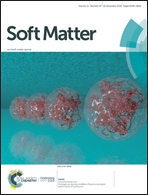Pressure-induced silk spinning mechanism in webspinners (Insecta: Embioptera)†
Abstract
The articulated appendages of arthropods are highly adaptable and potentially multifunctional, used for walking, swimming, feeding, prey capture, or other functions. Webspinners (Order Embioptera) are a paragon in this context. In contrast to other arthropods producing silk, they utilize their front feet for silk production. However, employing the same leg for alternative functions rather than for pure locomotion potentially imposes constraints and compromises. We here present morphological and experimental evidence for a “passive” pressure-induced silk spinning mechanism induced by external mechanical stimuli. Furthermore, we demonstrate that, as a consequence of the conflicting functions for their front feet, webspinners have evolved a unique style of walking that reduces the potentially problematic contact between silk ejectors and the substrate. Here we answer for the first time a long-term question within this enigmatic group of insects—how webspinners can use their front feet to spin their nanoscale silk. This knowledge may open the door for experimental studies on an artificial spinning process and for future utilization in applied fields of robotics or chemistry.



 Please wait while we load your content...
Please wait while we load your content...